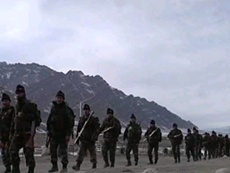Doklam II? India, China in fresh standoff near Arunachal border
03 Jan 2018
Indian and Chinese security forces are locked in a standoff near Bishing in Arunachal Pradesh's Upper Siang district for close to a week now, reports today said, citing the Indian security establishment.
 Chinese soldiers with road-building machines crossed up to 200 metres into Indian territory in Arunachal Pradesh in late December, almost reaching a border village in the Upper Siang district before Indian troops stopped them, locals in the border state told Hindustan Times (HT).
Chinese soldiers with road-building machines crossed up to 200 metres into Indian territory in Arunachal Pradesh in late December, almost reaching a border village in the Upper Siang district before Indian troops stopped them, locals in the border state told Hindustan Times (HT).
The standoff began after troops of India's Indo-Tibetan Border Police (ITBP) and the Indian Army were informed by local villagers that a Chinese road-building team had entered India with bulldozers.
''My friend was driving to a place which lies beyond Tuting. He was stopped by the Army, who said he cannot go further because a standoff between Indian and Chinese soldiers is on. The locals there too had confirmed this to my friend,'' an Arunachal-based lawyer-activist told The New Indian Express (NIE).
China's latest incursion comes four months after the two nuclear-armed neighbours ended a tense border standoff at Doklam plateau near the India-Bhutan-China tri-junction. It is unusual for this time of the year as the Chinese rarely launch incursions in winter.
A security establishment source told HT that there is ''no face-off now'' but that the ''Chinese have left their road construction material on the site''.
Locals say Indian security personnel intercepted the Chinese troops near Bising village under Tuting subdivision along the eastern bank of Siang River.
Indian soldiers confronted their Chinese counterparts and seized their road construction machines including two excavators. Some of the locals said they are not being allowed to go beyond Geling village, the next administrative circle after Tuting town and towards the border with China.
A source in the security establishment said the standoff began before the new year and ''is continuing as we speak''.
Another source said, ''We do not want to escalate matters and make a Doklam out of it. So the government has asked us not to go public.'' He was referring to the 72-day standoff between Indian and Chinese troops at Doklam in Bhutan last year that had escalated tension between the neighbours.
HT has learnt that the incursion took place around a week to 10 days ago, almost coinciding with a meeting of the special representatives of India and China in New Delhi. The two representatives, National Security Advisor Ajit Doval and Member of Politburo of Communist Party of China's Central Committee Yang Jiechi on 22 December, stressed the need to resolve border differences at the earliest and discussed confidence-building measures to ensure peace.
Duli Kamduk, the deputy commissioner of Upper Siang, told the paper, ''Our officials in Tuting subdivision have not reported any Chinese incursion. There is no word from the armed forces too.''
An Army spokesperson did not respond to queries. Army officials in the Northeast said any denial or confirmation of the incident was in the domain of the army headquarters.
The armies disengaged after China promised to make ''necessary adjustments'' to their troop deployment, and Indian troops withdrew to their posts in Sikkim.
In a narrative pieced together by NIE from sources in Arunachal Pradesh, last week, probably around 28 December, the Chinese road-building team was spotted by villagers. The team included civilians as well as uniformed personnel.
The villagers informed a local policeman, who in turn alerted the ITBP deployed in Medog, near Bishing. The area is north of the Yarlung Tsangpo River, called Siang in India, after it enters Arunachal in an ''S'' bend.
The ITBP reached the spot and asked the Chinese to return. There was an exchange of words but the Chinese refused to yield. The Indian Army also sent a patrol to the faceoff site, where it continues to stay.
Though the site is part of the ITBP's area of responsibility, the Army is heavily deployed in the region. In December 2016, the Army and the Air Force re-activated an Advanced Landing Ground at Tuting where military cargo planes can fly from a short runway. The faceoff site is near the Gelling subdivision.
It is not clear if the standoff is over. Some say the civilians in the road-building team retreated to Chinese territory and the faceoff dissipated. Others say the standoff is still on and it occasionally involves bargaining over the custody of the dozers. There are more Chinese soldiers now since the road-building party was intercepted.
The district authorities as well as the Arunachal chief minister's office expressed ignorance on the incident. Local MP, Ninong Ering, too, did not have knowledge of the faceoff. ''The Army is not letting people go beyond Gelling village, which is the next administrative circle after Tuting town towards the international border,'' said the lawyer-activist.
A comparison with Doklam is easy but not quite accurate, as Doklam involved a third country, Bhutan. In this case, the standoff is firmly within Indian territory, about 4 km from the McMahon Line.













.jpg)






.jpg)









